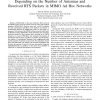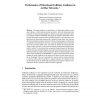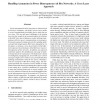36 search results - page 4 / 8 » On Hybrid Collision Control for IEEE 802.11 Ad-Hoc Networks |
MOBIHOC
2005
ACM
14 years 8 months ago
2005
ACM
IEEE 802.11 MAC, called the Distributed Coordination Function (DCF), employs carrier sensing to effectively avoid collisions, but this makes it difficult to maximally reuse the sp...
ICC
2007
IEEE
14 years 3 months ago
2007
IEEE
— MIMA-MAC is the most attractive MAC protocol for MIMO ad hoc networks, which consist of nodes with multiple antennas. MIMA-MAC, however, uses only a half of antennas for data t...
VTC
2010
IEEE
13 years 7 months ago
2010
IEEE
—Vehicular Ad-hoc NETworks (VANETs) adopting Dedicated Short-Range Communications (DSRCs) have emerged as a preferred choice of network design for the Intelligent Transportation ...
NETWORKING
2004
13 years 10 months ago
2004
Abstract. This paper analyzes the performance of directional collision avoidance schemes, in which antenna systems are used to direct the transmission and reception of control and ...
ICDCS
2005
IEEE
14 years 2 months ago
2005
IEEE
Power heterogeneous ad hoc networks are characterized by link layer asymmetry: the ability of lower power nodes to receive transmissions from higher power nodes but not vice versa...



